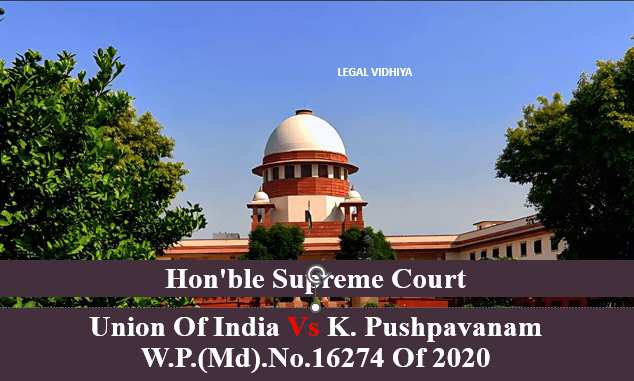
| Bench | Abhay S. Oka, Sanjay Karol |
| Date of Judgment | 11 August, 2023 |
| Court | Supreme Court of India |
| Petitioner | K. Pushpavanam |
| Respondent | The Union of India and others, including the State of Tamil Nadu and various governmental departments like the Law Commission of India, Ministry of Law and Justice, Ministry of Parliamentary Affairs. |
| Referred | Legal Frameworks:Article 226 of the Constitution of IndiaGovernment of India Act 1858Government of India Act 1915Government of India Act 1935Articles 294 and 300 of the Indian ConstitutionPrevious Judicial Cases:John Stuart’s Case (1775)Municipal Corporation of Delhi vs. Uphaar Tragedy Victims AssociationVadodara Municipal Corporation vs. Purshottam V. MurjaniState of Rajasthan vs. Vidyavati (1962)Kasturi Lal Ralia Ram vs. State of Uttar Pradesh (1965)Nagendra Rao vs. State of Andhra Pradesh (1994)Vishaka vs. State of Rajasthan (1997)Gainda Ram vs. MCD (2010)P. Sudhir vs. Bar Council of India (1999) |
FACTS OF THE CASE
- The case filed by K. Pushpavanam under Article 226 of the Constitution of India aimed to address a significant gap in Indian law concerning the absence of specific legislation on “Torts and State Liability.” This issue had persisted despite several Supreme Court judgments, such as “MCD vs. Uphaar Tragedy Victims Association” and “Vadodara Municipal Corporation vs. Purshottam V. Murjani,” highlighting the need for such legislation, as well as recommendations from the Law Commission.
- Motivated by the legislative inaction to enact laws or amendments as suggested by the judiciary in this domain, the petitioner sought a Writ of Mandamus to compel the respondents, mainly the Union of India and its related departments, to initiate comprehensive legislation in this field. The Court’s investigation into this matter included a historical review of legislative inaction, tracing back to the East India Company period and encompassing the evolution of legal frameworks under the Government of India Acts of 1858, 1915, and 1935, as well as post-independence developments.
- The case further involved discussions on the role and impact of the Law Commission in recommending legal reforms, highlighting the lack of subsequent legislative action on these recommendations. Responses from the respondents to the Court’s specific queries regarding the implementation of judicial recommendations were found to be vague or non-committal, revealing an absence of a systematic government mechanism to process and act upon such judicial suggestions.
- The trial court’s decision and ensuing directions were formulated based on these facts, focusing on bridging the identified gap between judicial recommendations for legal reforms and the corresponding legislative action or inaction.
JUDGEMENT
- Introduction of a Bill on Torts and State Liability: The Court directed the Government to consider introducing a bill akin to the “Liability in Tort” bill of 1965 and 1967 within six months, adapting to the current context.
- Status of the Law Commission: The Court ordered the Central Government to decide on making the Law Commission a statutory or constitutional body within six months.
- Funding and Infrastructure for the Law Commission: The Government was directed to allocate more funds to the Law Commission for research and infrastructural development.
- Appointment in the Law Commission: The respondents were required to appoint the Chairman and Members of the Law Commission of India within three months, with a provision for the appearance of Respondents 1 & 3 before the Court upon failure to comply.
- Appointment of Nodal Officers: The Court mandated each government department to appoint a legally qualified “Nodal Officer” to document judicial recommendations and relay these to policymakers within six months.
Basis and Reasoning of the Judgment:
The judgment was grounded in the historical context of the legislative body’s inaction in India regarding judicial recommendations for legal reforms. The Court noted the absence of specific legislation in the area of “Torts and State Liability,” despite clear directives in various landmark Supreme Court judgments and recommendations from the Law Commission. The Court emphasized the importance of a systematic mechanism within the government to track and act upon judicial recommendations, aiming to bridge the gap between judicial directives and legislative action.
Significance of the Judgment:
The judgment is significant as it underscores the judiciary’s proactive role in addressing gaps in the legal framework, particularly in cases where legislative action has been lacking. It highlights the importance of timely and effective legislative responses to judicial directives and expert recommendations, ensuring that the legal system remains responsive to society’s evolving needs.
In summary, the judgment represents a significant step in addressing the systemic challenges in the legislative response to judicial recommendations, particularly in the area of State liability in torts. The directions issued by the Court reflect an effort to enhance the interconnected roles of the judiciary and the legislature in the governance process.
REFERENCES
https://indiankanoon.org/doc/20362458/
This Article is written by Rhythm Sharma of Aligarh Muslim University, Intern at Legal Vidhiya.
Disclaimer: The materials provided herein are intended solely for informational purposes. Accessing or using the site or the materials does not establish an attorney-client relationship. The information presented on this site is not to be construed as legal or professional advice, and it should not be relied upon for such purposes or used as a substitute for advice from a licensed attorney in your state. Additionally, the viewpoint presented by the author is of a personal nature.




0 Comments